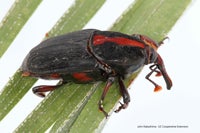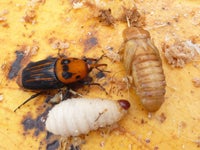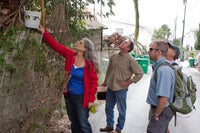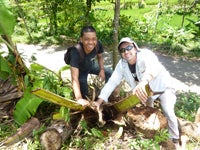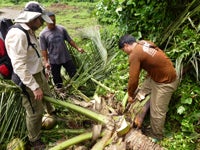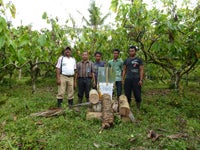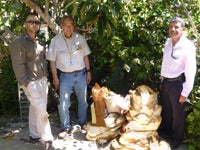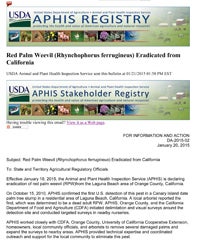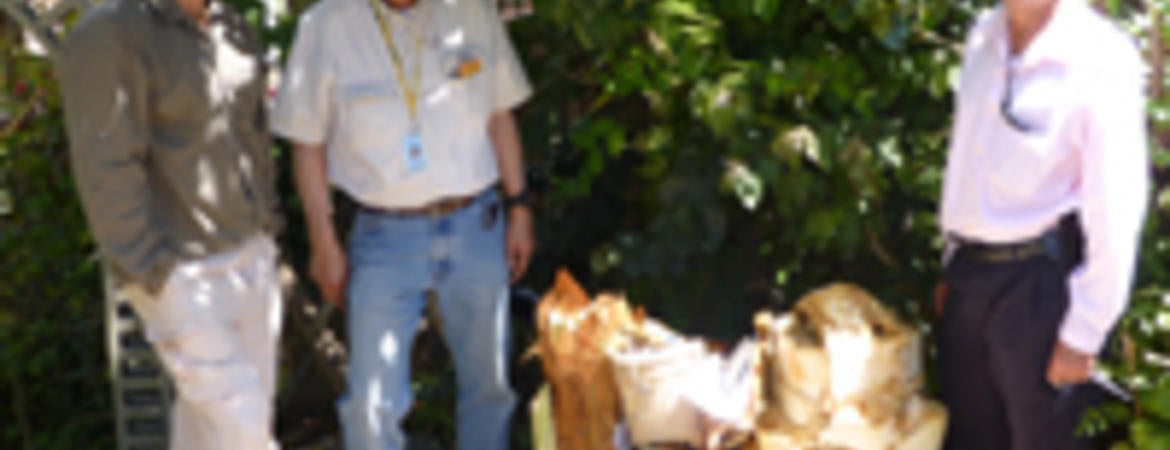
|
Fig. 1. Rhynchophorus vulneratus, the palm weevil discovered in Laguna Beach, California in October 2012. |
|
Fig. 2. Red palm weevil, Rhynchophorus ferrugineus, adult, larva (white grub), and pupa extracted from a Canary Islands date palm in France. |
|
Fig. 3. Dead Canary Islands date palm killed by R. vulneratus in Laguna Beach. |
|
Fig. 4. Red palm weevil Technical Working Group inspecting pheromone traps in Laguna Beach. |
|
Fig. 5. Collecting R. vulneratus from dead coconut palms in Java Indonesia. |
|
Fig. 6. Collecting palm weevils in the Philippines. |
|
Fig. 7. Testing aggregation pheromone and cut coconut logs in Sumatra Indonesia for attraction to R. vulneratus. |
|
Fig. 8. Aerating adult R. vulneratus for collection of aggregation pheromone in Sumatra Indonesia. |
|
Fig. 9. Enhanced trapping trial at Laguna Beach utilized freshly cut date palm trunks and aggregation pheromone. |
|
Fig. 10. Injecting a systemic insecticide into the soil around the roots of a weevil infested palm tree in Laguna Beach. |
|
Fig. 11. Eating cooked red palm weevil larvae for lunch in Thailand. These larvae were reared commercially in a weevil farm. |
|
Figure 12. USDA declaration of the successful eradication of R. vulneratus from Laguna Beach in January 2015. |
In October 2010 a live large black weevil with a red stripe on the thorax (Fig. 1) was found inside the trunk of a dead Canary Islands date palm in Laguna Beach. This weevil was originally identified as the red palm weevil, Rhynchophorus ferrugineus (Fig. 2). Subsequent work by researchers at UC Riverside using DNA analyses conclusively demonstrated that the weevil found in Laguna Beach was not R. ferrugineus, but a related species of palm weevil, R. vulneratus. These two species of weevils, R. ferrugineus and R. vulneratus, both native to southeast Asia, were incorrectly synonymized by Canadian researchers in 2004 and were subsequently referred to as R. ferrugineus, the red palm weevil, a notorious invasive pest of palms. The weevil-infested palm tree in Laguna Beach (Fig. 3) was promptly removed and a technical working group (Fig. 4) for “red palm weevil” was formed (at this stage of the invasion the correct identity of the weevil was not known and the weevil species in Laguna was referred to as red palm weevil [RPW]; for consistency across blog posts, this incorrect common name will be used here to refer to R. vulneratus).
Rapid action was taken against R. vulneratus and pesticide applications were applied to palm trees showing signs of probable infestation which were readily identified because of obvious feeding damage to palm fronds. As work on RPW was under way in Laguna Beach studies targeting R. vulneratus in Indonesia (Fig. 5) and the Philippines (Fig. 6) were initiated and observations on R. ferrugineus management in France were made.
The studies conducted in Indonesia and the Philippines demonstrated that the commercially-available aggregation pheromone sold for R. ferrugineus was effective at attracting R. vulneratus in its native habitat. This was not a great surprise as the aggregation pheromone was originally isolated from R. vulneratus and not R. ferrugineus as originally thought (in fact the aggregation pheromone for R. ferrugineus is not known, but this weevil species finds the R. vulneratus aggregation pheromone very attractive, perhaps suggesting that they are similar).
The results of these field studies were important because trapping programs using the commercially-available aggregation by the California Department of Food and Agriculture in Laguna Beach were failing to capture adult weevils even though weevil feeding damage to palms was being observed. A key factor in the overseas field trials with the aggregation pheromone was the incorporation of cut palm trunks. The combination of cut palm trunks with aggregation pheromone greatly increased captures of weevils in Indonesia and the Philippines (Fig. 7). The aggregation pheromone from R. vulneratus was reanalyzed with new material that was collected during aeration trials in Sumatra Indonesia (Fig. 8). The pheromone was identical to the commercially-available pheromone that had been originally collected from R. vulneratus in Java Indonesia (this weevil species in Java was incorrectly identified as R. ferrugineus by the scientist that originally did this work.)
Field experiments in the home range of R. vulneratus demonstrated that the combination of commercially-available aggregation pheromone and cut palm trunks captured significantly more weevils than either treatment alone. Consequently, this lead to the initiation of “enhanced” trapping trials in Laguna (Fig. 9) that used a combination of cut date palm trunks provided by cooperators in the Coachella Valley and aggregation pheromone. These enhanced trapping trials also failed to capture weevils.
Removal and dissection of palm trees previously identified as being infested with R. vulneratus and treated with pesticides (Fig. 10) indicated that palms had been “cured” of infestations. This finding likely explained why the pheromone traps were not capturing weevils. Prompt action directed towards to infested palm trees while the R. vulneratus infestation was highly localized and weevil populations were very small was probably responsible for the eradication of this pest from Laguna Beach.
A big question that remains largely unresolved is how did R. vulneratus come to Laguna Beach, a relatively isolated coastal city with no international airports or seaports? Our working hypothesis for which we have no direct evidence is that this pest may have been deliberately introduced as a traditional food (Fig. 11) and that Bali Indonesia is close to the possible area of origin for the Laguna population.
The last live weevil was detected in Laguana on 18 January 2012. Three years subsequently passed with no further detections of. Because three consecutive years passed with no weevil detections in Laguna Beach USDA-APHIS declared this pest to be officially eradicated on 21 January 2015 (Fig. 12). This is a significant accomplishment against a notoriously destructive palm pest.
